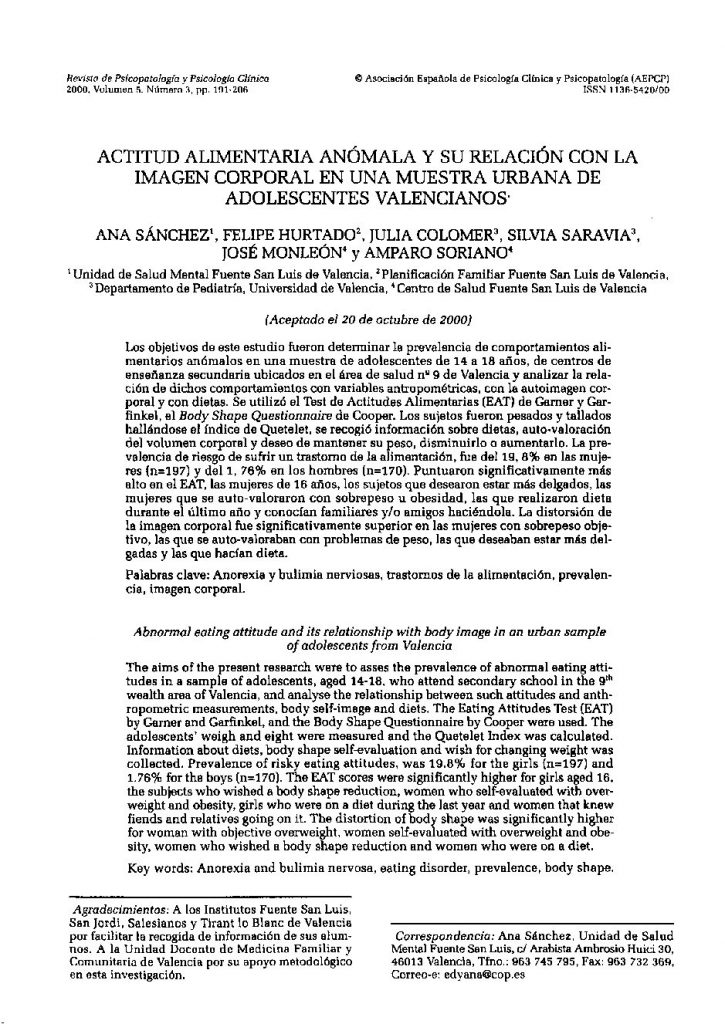Actitud alimentaria anómala y su relación con la imagen corporal en una muestra urbana de adolescentes valencianos.

- Predicción de la sintomatología somática a partir del estrés diario: un estudio prospectivo controlando el efecto del neuroticismo.
- Análisis del uso de estrategias de afrontamiento en la Enfermedad Pulmonar Obstructiva Crónica (EPOC): implicaciones conceptuales.
- Actitud alimentaria anómala y su relación con la imagen corporal en una muestra urbana de adolescentes valencianos.
- Horario laboral y salud: Consecuencias psicológicas de los turnos de trabajo.
- Informe sobre la Comisión Nacional de la Especialidad de Psicología Clínica.
The aims of the present research were to asses the prevalence of abnormal eating attitudes in a sample of adolescents, aged 14-18, who attend secondary school in the 9th wealth area of Valencia, and analyse the relationship between such attitudes and anthropometric measurements, body self-image and diets. The Eating Attitudes Test (EAT) by Garner and Garfinkel, and the Body Shape Questionnaire by Cooper were used. The adolescents’ weigh and eight were measured and the Quetelet Index was calculated. Information about diets, body shape self-evaluation and wish for changing weight was collected. Prevalence of risky eating attitudes, was 19.8% for the girls (n=197) and 1,76% for the boys (n=170). The EAT scores were significantly higher for girls aged 16, the subjects who wished a body shape reduction, women who self-evaluated with overweight and obesity, girls who were on a diet during the last year and women that knew fiends and relatives going on it. The distortion of body shape was significantly higher for woman with objective overweight, women self-evaluated with overweight and obesity, women who wished a body shape reduction and women who were on a diet.
Los objetivos de este estudio fueron determinar la prevalencia de comportamientos alimentarios anómalos en una muestra de adolescentes de 14 a 18 años, de centros de enseñanza secundaria ubicados en el área de salud nº 9 de Valencia y analizar la relación de dichos comportamientos con variables antropométricas, con la autoimagen corporal y con dietas. Se utilizó el Test de Actitudes Alimentarias (EAT) de Garner y Garfinkel, el Body Shape Questionnaire de Cooper. Los sujetos fueron pesados y tallados hallándose el índice de Quetelet, se recogió información sobre dietas, auto-valoración del volumen corporal y deseo de mantener su peso, disminuirlo o aumentarlo. La prevalencia de riesgo de sufrir un trastorno de la alimentación, fue del 19,8% en las mujeres (n=197) y del 1,76% en los hombres (n=170). Puntuaron significativamente más alto en el EAT, las mujeres de 16 años, los sujetos que desearon estar más delgados, las mujeres que se auto-valoraron con sobrepeso u obesidad, las que realizaron dieta durante el último año y conocían familiares y/o amigos haciéndola. La distorsión de la imagen corporal fue significativamente superior en las mujeres con sobrepeso objetivo, las que se auto-valoraban con problemas de peso, las que deseaban estar más delgadas y las que hacían dieta.



